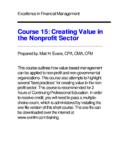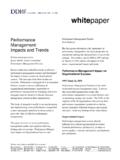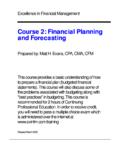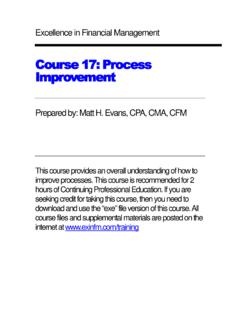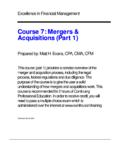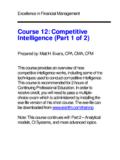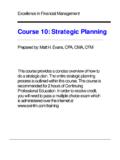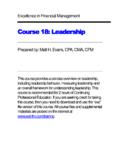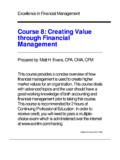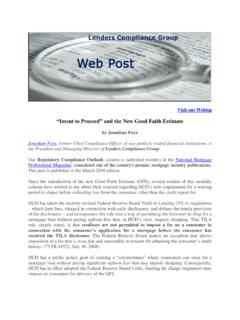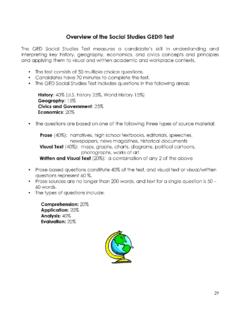Transcription of Course 12: Competitive Intelligence (PIntelligence …
1 Course 12: Competitive Course 12: Competitive Course 12: Competitive Course 12: Competitive Intelligence (PIntelligence (PIntelligence (PIntelligence (Part 2 of 2) art 2 of 2) art 2 of 2) art 2 of 2) Prepared by: Matt H. Evans, CPA, CMA, CFM This Course provides more in-depth coverage about Competitive Intelligence specific techniques and models used as well as CI Systems. Before taking this Course , you should complete Part 1 of this Course . This Course is recommended for 2 hours of Continuing Professional Education. In order to receive credit, you will need to pass a multiple-choice exam which you can take over the internet at Excellence in Financial Management 2 Critical Concepts Before we get into Part 2 of this short Course , let s touch on the fundamentals behind Competitive Intelligence .
2 From Part 1 of this Course , we learned that Competitive Intelligence relies on a very analytical process to transform data and information into Intelligence . We also understand that Competitive Intelligence is not just about studying the competition, but studying the entire external landscape - customers, suppliers, regulators, and all forces that impact the organization. Therefore, our analysis must be very broad in scope. The primary output from Competitive Intelligence is the ability to make forward-looking decisions. For example, Jack Welch, former CEO of General Electric determined strategy based on key Intelligence questions: - What is the detailed global position of your business and that of your competitors: market shares, strengths by product line, and by region today?
3 - What actions have your competitors taken in the past two years that have changed the Competitive landscape? - What are you most afraid your competitors might do in the next two years to change the landscape? Therefore, Competitive Intelligence drives strategic decision-making and market leadership. Part 1 of this short Course also emphasized several important points about Competitive Intelligence , such as the following: Human Intelligence is often more valuable than simply collecting published information. This is a more direct approach to information analysis. One of the fastest ways to learn about your competitors and their products is to attend an industry trade show.
4 Since Competitive Intelligence is externally driven, it can be invaluable for risk management. Risk management functions are internally focused and in need of external analysis that comes from Competitive Intelligence . Competitive Intelligence is not complete unless you engage in Counter Intelligence . You need to protect your company against Intelligence leaks that benefit the competition. Chapter 1 If the defining goal of modern day business can be isolated to just one item, it would be the search for Competitive advantage. And, as everyone in business knows, it s a lot harder than it used to be. On the one hand, competition is more intense than ever technological innovation, consumer expectations, government deregulation all combine to create more opportunities for new competitors to change the basic rules of the game.
5 - Competing by Design: The Power of Organizational Architecture by David A. Nadler and Michael L. Tushman with Mark B. Nadler 3 One of the big drivers behind Competitive Intelligence is the use of analytical models. We touched on a few of these models in Part 1 Porter s Five Forces Model, Scenario Analysis and War Games. However, there are over 100 analytical models and each CI Project may require one or more specific analytical approaches. So we need a better understanding of analytical models. Part 2 of this short Course (which you are about to study) will outline several analytical models and how to apply them. The basic starting point for Competitive Intelligence is to define the problem or issue.
6 Everything else feeds from a Key Intelligence Topic or KIT. KIT s direct and guide much of your analysis. Likewise, your analysis could lead to some KIT s that management has not raised. However, the big driver behind your KIT s should be a dialogue between the CI Professional and management. Competitive Intelligence should be a value-added service to managers who are facing critical strategic decisions. Here are a few examples of Key Intelligence Topics: - What impact will nanotechnology have on our high volume product line? - How is our competitor able to retain major government contracts year after year when these contracts come open for bid? - What is the timeline for when our competitor will launch their new Asian services?
7 - Should we expand our Texas facility or build a new facility in Ohio? - Who are the key customers of our competitor? - How does this new regulation impact our business? - How well does this supplier perform with other companies? These key Intelligence topics provide the baseline for our research and analysis. To keep the KIT process flowing, CI ( Competitive Intelligence ) Professionals should aggressively seek out the specific Intelligence needs of Managers. This is very important for a number of reasons: 1. Provides focus for the overall CI Program within your company. 2. Gives you insights into what resources you need critical skills, external sources of information, etc.
8 3. Allows you to categorize Intelligence requirements so you can plan and organize the CI Program. 4. Reduces duplicative efforts since KIT s may overlap and compliment one another. Key Intelligence Topics Key Point Perception over Precision Competitive Intelligence is more concerned with understanding the big picture and having the right perception of the marketplace. Competitive Intelligence is not pre-occupied with exact precision since we are trying to gain insights into the major forces impacting our company through various analytical models. 4 This pro-active approach to CI will require regular meetings and surveys to assess the needs of your users. You should also include a satisfaction evaluation finding out how you can improve Competitive Intelligence for your Intelligence customers.
9 Additionally, it is a good idea to sell Competitive Intelligence to your customer base. Most managers will not understand the benefits of Competitive Intelligence . Therefore, some form of training can help solidify a partnership between providers of Competitive Intelligence and the users of Competitive Intelligence . For example, CI Professionals can help identify the most likely moves of key competitors. This kind of information is valuable to those engaged in strategic planning. Even a simple alert service can help things like new technology, changes in government regulations and sudden moves by competitors. Now that we understand the start of the process, namely the importance of defining a Key Intelligence Topic, we will shift our focus to the end of the process, reporting Competitive Intelligence to end-users.
10 It s worth noting that as we reach the end of the CI Process, we should spend a lot of time on communication and feedback. For example, many CI Analyst tend to spend most of their time on the upfront part of the CI Life Cycle; namely research and analysis. However, the most effective forms of CI tend to spend almost one-third of their life cycles engaged in communication and feedback with the users of CI. This is important since CI results tend to unfold as you work your way through the process and regular communication will help redirect the CI Project so that the final results deliver exactly what the user really needs. Even simple forms of regular communication are important, such as unexpected delays, inability to meet due dates, and other updates for the CI end-user.
